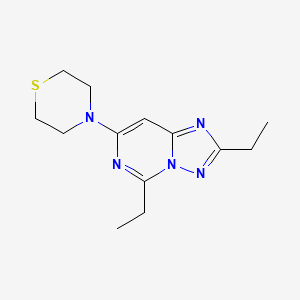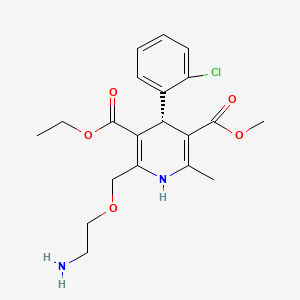
(R)-Amlodipine
Descripción general
Descripción
®-Amlodipine is a chiral calcium channel blocker used primarily in the treatment of hypertension and angina. It is the enantiomer of amlodipine, which means it has a specific three-dimensional arrangement that distinguishes it from its mirror image. This compound works by inhibiting the influx of calcium ions into vascular smooth muscle and cardiac muscle, leading to vasodilation and reduced blood pressure.
Métodos De Preparación
Synthetic Routes and Reaction Conditions
The synthesis of ®-Amlodipine typically involves the resolution of racemic amlodipine or asymmetric synthesis. One common method is the chiral resolution of racemic amlodipine using chiral acids or bases to separate the enantiomers. Another approach is the asymmetric synthesis, which involves the use of chiral catalysts or chiral auxiliaries to produce the desired enantiomer directly.
Industrial Production Methods
In industrial settings, the production of ®-Amlodipine often involves large-scale chiral resolution techniques. These methods are optimized for high yield and purity, ensuring that the final product meets pharmaceutical standards. The use of advanced chromatographic techniques and crystallization methods is common in the industrial production of ®-Amlodipine.
Análisis De Reacciones Químicas
Types of Reactions
®-Amlodipine undergoes several types of chemical reactions, including:
Oxidation: It can be oxidized under specific conditions to form various metabolites.
Reduction: Reduction reactions can modify the structure of ®-Amlodipine, potentially altering its pharmacological properties.
Substitution: Nucleophilic substitution reactions can occur, leading to the formation of different derivatives.
Common Reagents and Conditions
Oxidation: Common oxidizing agents include potassium permanganate and hydrogen peroxide.
Reduction: Reducing agents such as lithium aluminum hydride and sodium borohydride are used.
Substitution: Nucleophiles like amines and thiols can react with ®-Amlodipine under appropriate conditions.
Major Products Formed
The major products formed from these reactions include various metabolites and derivatives that may have different pharmacological activities. These products are often studied to understand the metabolism and potential side effects of ®-Amlodipine.
Aplicaciones Científicas De Investigación
Chemistry
In chemistry, ®-Amlodipine is used as a model compound to study chiral resolution techniques and asymmetric synthesis. Researchers explore new methods to improve the efficiency and selectivity of these processes.
Biology
In biological research, ®-Amlodipine is used to study calcium channel function and the role of calcium ions in cellular processes. It serves as a tool to investigate the mechanisms of calcium channel blockers and their effects on various cell types.
Medicine
Medically, ®-Amlodipine is extensively studied for its therapeutic effects in treating hypertension and angina. Clinical trials and pharmacological studies aim to understand its efficacy, safety, and potential side effects.
Industry
In the pharmaceutical industry, ®-Amlodipine is used as a reference standard for quality control and formulation development. Its production and quality assurance processes are critical for ensuring the availability of safe and effective medications.
Mecanismo De Acción
®-Amlodipine exerts its effects by inhibiting the influx of calcium ions through L-type calcium channels in vascular smooth muscle and cardiac muscle. This inhibition leads to vasodilation, reduced peripheral resistance, and decreased blood pressure. The molecular targets of ®-Amlodipine include the alpha-1 subunit of the L-type calcium channel. By binding to this subunit, ®-Amlodipine stabilizes the channel in its inactive state, preventing calcium entry and subsequent muscle contraction.
Comparación Con Compuestos Similares
Similar Compounds
Amlodipine: The racemic mixture containing both ®- and (S)-enantiomers.
Nifedipine: Another calcium channel blocker with a similar mechanism of action.
Felodipine: A dihydropyridine calcium channel blocker used for similar indications.
Uniqueness
®-Amlodipine is unique due to its specific chiral configuration, which can result in different pharmacokinetic and pharmacodynamic properties compared to its (S)-enantiomer and racemic mixture. Studies have shown that ®-Amlodipine may have a more favorable side effect profile and potentially greater efficacy in certain patient populations.
Conclusion
®-Amlodipine is a valuable compound in the treatment of hypertension and angina, with distinct chemical, biological, and pharmacological properties. Its synthesis, reactions, and applications continue to be areas of active research, contributing to the development of more effective and safer medications.
Propiedades
IUPAC Name |
3-O-ethyl 5-O-methyl (4R)-2-(2-aminoethoxymethyl)-4-(2-chlorophenyl)-6-methyl-1,4-dihydropyridine-3,5-dicarboxylate | |
|---|---|---|
| Source | PubChem | |
| URL | https://pubchem.ncbi.nlm.nih.gov | |
| Description | Data deposited in or computed by PubChem | |
InChI |
InChI=1S/C20H25ClN2O5/c1-4-28-20(25)18-15(11-27-10-9-22)23-12(2)16(19(24)26-3)17(18)13-7-5-6-8-14(13)21/h5-8,17,23H,4,9-11,22H2,1-3H3/t17-/m1/s1 | |
| Source | PubChem | |
| URL | https://pubchem.ncbi.nlm.nih.gov | |
| Description | Data deposited in or computed by PubChem | |
InChI Key |
HTIQEAQVCYTUBX-QGZVFWFLSA-N | |
| Source | PubChem | |
| URL | https://pubchem.ncbi.nlm.nih.gov | |
| Description | Data deposited in or computed by PubChem | |
Canonical SMILES |
CCOC(=O)C1=C(NC(=C(C1C2=CC=CC=C2Cl)C(=O)OC)C)COCCN | |
| Source | PubChem | |
| URL | https://pubchem.ncbi.nlm.nih.gov | |
| Description | Data deposited in or computed by PubChem | |
Isomeric SMILES |
CCOC(=O)C1=C(NC(=C([C@H]1C2=CC=CC=C2Cl)C(=O)OC)C)COCCN | |
| Source | PubChem | |
| URL | https://pubchem.ncbi.nlm.nih.gov | |
| Description | Data deposited in or computed by PubChem | |
Molecular Formula |
C20H25ClN2O5 | |
| Source | PubChem | |
| URL | https://pubchem.ncbi.nlm.nih.gov | |
| Description | Data deposited in or computed by PubChem | |
DSSTOX Substance ID |
DTXSID90430938 | |
| Record name | (R)-Amlodipine | |
| Source | EPA DSSTox | |
| URL | https://comptox.epa.gov/dashboard/DTXSID90430938 | |
| Description | DSSTox provides a high quality public chemistry resource for supporting improved predictive toxicology. | |
Molecular Weight |
408.9 g/mol | |
| Source | PubChem | |
| URL | https://pubchem.ncbi.nlm.nih.gov | |
| Description | Data deposited in or computed by PubChem | |
CAS No. |
103129-81-3 | |
| Record name | (+)-Amlodipine | |
| Source | CAS Common Chemistry | |
| URL | https://commonchemistry.cas.org/detail?cas_rn=103129-81-3 | |
| Description | CAS Common Chemistry is an open community resource for accessing chemical information. Nearly 500,000 chemical substances from CAS REGISTRY cover areas of community interest, including common and frequently regulated chemicals, and those relevant to high school and undergraduate chemistry classes. This chemical information, curated by our expert scientists, is provided in alignment with our mission as a division of the American Chemical Society. | |
| Explanation | The data from CAS Common Chemistry is provided under a CC-BY-NC 4.0 license, unless otherwise stated. | |
| Record name | Amlodipine, (+)- | |
| Source | ChemIDplus | |
| URL | https://pubchem.ncbi.nlm.nih.gov/substance/?source=chemidplus&sourceid=0103129813 | |
| Description | ChemIDplus is a free, web search system that provides access to the structure and nomenclature authority files used for the identification of chemical substances cited in National Library of Medicine (NLM) databases, including the TOXNET system. | |
| Record name | (R)-Amlodipine | |
| Source | EPA DSSTox | |
| URL | https://comptox.epa.gov/dashboard/DTXSID90430938 | |
| Description | DSSTox provides a high quality public chemistry resource for supporting improved predictive toxicology. | |
| Record name | AMLODIPINE, (R)- | |
| Source | FDA Global Substance Registration System (GSRS) | |
| URL | https://gsrs.ncats.nih.gov/ginas/app/beta/substances/YUH55G7ZTY | |
| Description | The FDA Global Substance Registration System (GSRS) enables the efficient and accurate exchange of information on what substances are in regulated products. Instead of relying on names, which vary across regulatory domains, countries, and regions, the GSRS knowledge base makes it possible for substances to be defined by standardized, scientific descriptions. | |
| Explanation | Unless otherwise noted, the contents of the FDA website (www.fda.gov), both text and graphics, are not copyrighted. They are in the public domain and may be republished, reprinted and otherwise used freely by anyone without the need to obtain permission from FDA. Credit to the U.S. Food and Drug Administration as the source is appreciated but not required. | |
Synthesis routes and methods I
Procedure details






Synthesis routes and methods II
Procedure details





Synthesis routes and methods III
Procedure details




Synthesis routes and methods IV
Procedure details





Synthesis routes and methods V
Procedure details





Retrosynthesis Analysis
AI-Powered Synthesis Planning: Our tool employs the Template_relevance Pistachio, Template_relevance Bkms_metabolic, Template_relevance Pistachio_ringbreaker, Template_relevance Reaxys, Template_relevance Reaxys_biocatalysis model, leveraging a vast database of chemical reactions to predict feasible synthetic routes.
One-Step Synthesis Focus: Specifically designed for one-step synthesis, it provides concise and direct routes for your target compounds, streamlining the synthesis process.
Accurate Predictions: Utilizing the extensive PISTACHIO, BKMS_METABOLIC, PISTACHIO_RINGBREAKER, REAXYS, REAXYS_BIOCATALYSIS database, our tool offers high-accuracy predictions, reflecting the latest in chemical research and data.
Strategy Settings
| Precursor scoring | Relevance Heuristic |
|---|---|
| Min. plausibility | 0.01 |
| Model | Template_relevance |
| Template Set | Pistachio/Bkms_metabolic/Pistachio_ringbreaker/Reaxys/Reaxys_biocatalysis |
| Top-N result to add to graph | 6 |
Feasible Synthetic Routes
Q1: What is the primary mechanism of action of (R)-amlodipine?
A1: Unlike its (S)-enantiomer, this compound does not exhibit significant calcium channel blocking activity. Instead, research suggests its primary mechanism involves inhibiting smooth muscle cell migration. [, , ]
Q2: What are the downstream effects of this compound's inhibition of smooth muscle cell migration?
A2: Inhibiting smooth muscle cell migration is particularly relevant in conditions like atherosclerosis and restenosis, where the excessive proliferation and migration of these cells contribute to disease progression. [, ] By hindering this process, this compound might offer therapeutic benefits in these areas.
Q3: What is the molecular formula and weight of this compound?
A3: this compound shares the same molecular formula and weight as its racemic mixture and (S)-enantiomer. The molecular formula is C20H25ClN2O5, and the molecular weight is 408.88 g/mol.
Q4: Is there spectroscopic data available for this compound?
A4: While specific spectroscopic data for this compound might be limited due to its existence as an enantiomer within the racemic mixture, studies utilize techniques like nuclear magnetic resonance (NMR) to characterize the solvates of this compound salts. For instance, one study reports the 1H NMR spectrum of the dimethylformamide solvate of this compound L-hemitartrate. []
Q5: What are the challenges in formulating this compound for pharmaceutical use?
A5: Like many chiral drugs, formulating this compound presents challenges in achieving enantiomeric purity, stability, and optimal bioavailability. Researchers explore various strategies, including the use of specific solvents, resolving agents, and formulation techniques to overcome these hurdles. [, , , ]
Q6: How is this compound absorbed, distributed, metabolized, and excreted (ADME) in the body?
A6: While this compound lacks the calcium channel blocking activity of its (S)-enantiomer, research indicates it exhibits different pharmacokinetic properties. Studies in healthy volunteers show that this compound is more rapidly eliminated from plasma compared to (S)-amlodipine. [] Further research is needed to comprehensively understand its specific ADME profile.
Q7: Are there any in vitro studies demonstrating the effects of this compound on smooth muscle cell migration?
A7: While the provided abstracts don't offer detailed in vitro data, they highlight this compound's potent inhibition of smooth muscle cell migration. [, , ] Further research is crucial to elucidate the specific molecular mechanisms underlying this effect.
Descargo de responsabilidad e información sobre productos de investigación in vitro
Tenga en cuenta que todos los artículos e información de productos presentados en BenchChem están destinados únicamente con fines informativos. Los productos disponibles para la compra en BenchChem están diseñados específicamente para estudios in vitro, que se realizan fuera de organismos vivos. Los estudios in vitro, derivados del término latino "in vidrio", involucran experimentos realizados en entornos de laboratorio controlados utilizando células o tejidos. Es importante tener en cuenta que estos productos no se clasifican como medicamentos y no han recibido la aprobación de la FDA para la prevención, tratamiento o cura de ninguna condición médica, dolencia o enfermedad. Debemos enfatizar que cualquier forma de introducción corporal de estos productos en humanos o animales está estrictamente prohibida por ley. Es esencial adherirse a estas pautas para garantizar el cumplimiento de los estándares legales y éticos en la investigación y experimentación.
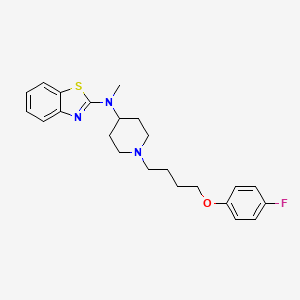
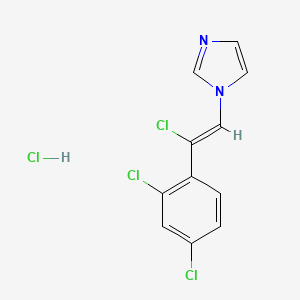
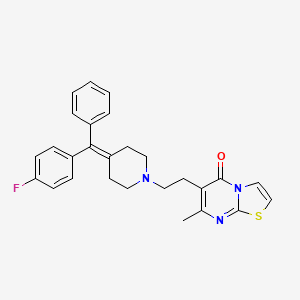


![3-Methoxy-6-[4-(3-methylphenyl)-1-piperazinyl]pyridazine](/img/structure/B1678722.png)
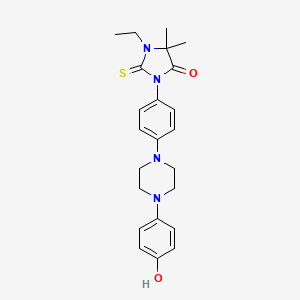
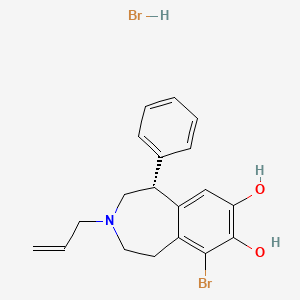


![(11S)-11-methyl-10-(3-methylbut-2-enyl)-1,3,10-triazatricyclo[6.4.1.04,13]trideca-4,6,8(13)-triene-2-thione](/img/structure/B1678730.png)
